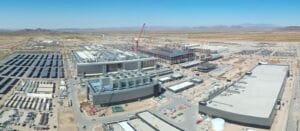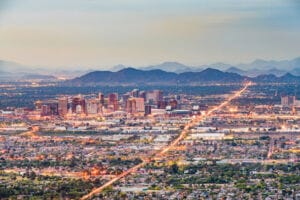Of the 15 Arizona school districts that asked voters in November to approve bonds to build or renovate education facilities, 11 got the go-ahead despite the lingering recession.
That’s good news for many of the state’s construction companies that have relied on publicly-funded projects to boost business and keep workers employed as private investment in new buildings plummeted with economy.
And for public entities with the need and the seed money, it’s a good time to snag a good deal in a highly competitive market for construction materials and services. But while public projects have helped, government spending has not been the great savior of the industry, according to Arizona’s construction company leaders.
The recession has taken its toll on public building plans with shrinking tax revenue sopping up funds pegged for new schools, city halls, police stations or libraries. And as absolutely essential projects get checked off the list, public spending is expected to dwindle. However, at least some projects are still getting budgeted and built, says Bo Calbert, president of McCarthy Building Companies’ Southwest Region.
“From 2003 to 2007, we probably had our best market in decades, but by 2008, everybody knew we were in trouble,” Calbert says.
“Private (projects) stopped overnight. Public work continued.”
Citing a recent market outlook report for Phoenix-Mesa-Scottsdale, Calbert says overall construction value slipped 40% in 2008 from its 2007 high, tumbled another 23% in 2009 and 27% in 2010. The report predicts 2011 value will increase 40% when the final numbers are compiled, but will sag slightly this year (2012) before heading back up in 2013.
Building During the Recession
Much of the 2011 increase is a result of federal stimulus funding for schools, infrstructure, solar-fueled projects and other green upgrades, Calbert says.
Among the infrastructure projects McCarthy landed is construction of the $140M, first phase of the PHX Sky Train, a people mover pegged to connect Phoenix

Sky Harbor International Airport visitors and employees to the terminals, light rail system and parking lots.
McCarthy’s usually packed education division had a 2011 workload values at about $110M, Calbert says. That’s down from a high of $170M in 2008. And about 40% of the 2011 business was out-of-state work as McCarthy took jobs in New Mexico to make up for Arizona’s shortfall.
“Public work has kept us going, but we had to go beyond Arizona,” he says. Among the school projects McCarthy snagged during the recession is a $20M addition and renovation for Barry Goldwater High School, says Terry Bohl, the company’s education services director. Parts of that multi-faceted project were completed during summer 2011 break, and other non-disruptive work is still ongoing, he says.
During the summer break, McCarthy completed 600,000 SF of school construction in Metro Phoenix, including the new buildings, renovations and mechanical upgrades. Still in the works is a new, $12M, 80,000 SF elementary school in Chandler, Bohl says.
Chandler is one of the few Arizona cities able to afford other-than-school public projects during the downturn. The city broke ground on a $74M city hall complex in mid-2009. After leasing, saving and budgeting for 25 years, Chandler didn’t have to borrow money to build it, says spokeswoman Jane Poston. Best of all, Chandler’s project came in $10M under original budget thanks to the sagging economy.
“We had significant cost savings building in a recession,” Poston says. Designing a much-needed firehouse as solar-fueled and LEED-certified helped Gilbert land a $3M federal grant from the American Recovery and Reinvestment Act, says spokeswoman Beth Lucas.
Maricopa County also saved a bundle by opting to build during the recession, says Thomas Goderre, district operations manager for Gilbane Building Company.
Gilbane teamed with Ryan Companies US on a 700,000 SF superior court tower in Downtown Phoenix (construction value $260M).
“The Maricopa County Court Tower project was big and constructed at the perfect time for Maricopa County, Gilbane/Ryan and the subcontractor community,” Goderre says. “The county was able to realize construction cost savings in the range of $15M to $20M compared to a normal construction climate, while Gilbane/Ryan and the local subcontractors were able to put a lot of people to work during a very tough economic downturn.”
The court tower was completed in November. That, along with a new Phoenix Politce precinct and four ASU student recreation centers, are among the publicly funded projects that “helped us weather the storm,” Goderre says.
Looking For New Opportunities
In Arizona, about 75% of Gilbane’s business has been publicly funded projects, he says, but Goderre sees that changing as public money dies up and private investment returns to the market.
Sundt Construction vice president Jeff Fairman says he also believes privately funded projects will take over more of his company’s resources during the next few years as cities and school districts continue to get squeezed.
Tempe-based Sundt bills about $1B in a normal year. Business has dropped overall during the recession, but the company’s 50/50 ration of public/private business has so far remained static, Fairman says.
Sundt has about $500M worth of public work in progress right now, but most of that is in multi-year projects, he says.
Both the volume of new business and overall construction value have shrunk as pre-recession plans that weren’t shelved were at least downsized. “The bells and whistles went away,” he says.
Besides building the new Chandler City Hall complex, Sundt landed a potpourri of publicly-funded projects during the economic downturn including K-8 and higher education buildings, municipal infrastructure projects, a federal courthouse and a U.S. Marine Corps simulator facility in Yuma.
Mesa-based Caliente Construction has specialized in upgrading or repurposing existing facilities during the downturn, says CEO Lorraine Bergman. The company is renovating old post office space to accommodate a student center for ASU’s Downtown Phoenix campus. Caliente has several projects completed or ongoing to make security, technology or mechanical improvements in public buildings from schools to prisons, Bergman says. “It’s come down to necessity. You can’t let the buildings fall apart,” she says.
Kitchell president Jim Swanson says the public sector produces “a sizable piece of our business,” typically employing about 30 percent of the company’s workforce in Arizona and California.
Commercial construction work is down for nearly all Kitchell’s business segments, Swanson says. And public projects in no way take up the slack, he says. Instead, he’d give props to the healthcare industry for keeping his business healthy.



